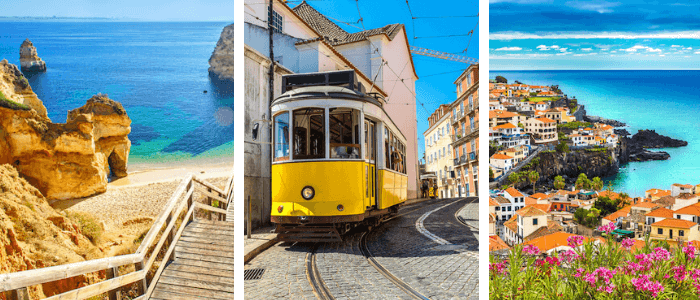PORTUGAL
Portugal is a country where the sun shines 300 days a year, a country with an amazing history, an extraordinary culture, delicious gastronomy, magnificent landscape, beautiful beaches, mountains greater than you can imagine and warm people that will make you feel at home.
Portugal is one of those rare countries in the world that once you visit, you will never forget.
(Day 1) Land in Porto (Fly from India/Barcelona),
Porto City in Portugal
Porto is a coastal city in northwest Portugal known for its stately bridges and port wine production. In the medieval Ribeira (riverside) district, narrow cobbled streets wind past merchants’ houses and cafes. São Francisco Church is known for its lavish baroque interior with ornate gilded carvings. The palatial 19th-century Palácio de Bolsa, formerly a stock market, was built to impress potential European investors.
Clérigos Tower is the iconic baroque bell tower of Clérigos Church. An old tram follows the river to beachside bars in affluent Foz. Up the coast is fishing port Matosinhos, where seafood restaurants offer grilled sardines on the street. The 1886 Dom Luís iron bridge has a walkway that crosses the Douro River to the port wine lodges of Vila Nova de Gaia. São Bento train station’s immense azulejo tile panels depict battles and rural life in Portugal. The famous Lello & Irmão bookstore has ornate art nouveau features, and the Serralves Museum traces the history of contemporary art.
The double-decker Dom Luis I bridge is an icon of the city of Porto. It spans the River Douro linking the Port wine houses of Vila Nova de Gaia with the bustling downtown Ribeira district of Porto. Construction took place between 1881 and 1886 with the bridge being built adjacent to an existing bridge which it replaced. The granite pillars of the original bridge are still in place, standing on the Ribeira like a pair of gate posts.
It is probably no coincidence that the bridge passes more than a fleeting resemblance of its neighbouring bridge, the Dona Maria Pia bridge. Both bridges consist of huge and complex ironwork frameworks with a great arch supporting the transit way. This should come as no surprise as the D. Maria Pia bridge was designed by Gustave Eiffel of Paris tower fame!
Dom Luis I Bridge http://travelbuddiestalk.com/wp-content/uploads/2018/05/Dom-Lu%C3%ADs-I-Bridge-1024×632.jpgOpened in 1876 the D. Maria Pia bridge held the record for the largest span of any bridge of this type until work began on the Dom Luís bridge. The names of the two bridges came from the then king of Portugal, Luís I, and his wife, Maria Pia of Savoy. With a span of 172 metres (564 ft) and a height of 44.6 metres (146 ft) this was a great feat of engineering. The designer this time, Téophile Seyrig, had been Eiffel’s partner on the previous project and showed himself to be a more than able engineer with this bridge.
One of the notable features of the Ponte Dom Luís I is it’s two levels; one on top of the arch and the other suspended below it. Both decks were initially intended to carry road traffic but these days the top carries the Porto Metro trains as well as having a pedestrian walkway. It is worth making the crossing on the upper level, although being 60 metres (190 ft) above the waters of the Douro, it might not be for everyone!
São Bento is Porto’s central station, although the exterior of this grand building barely hints at its purpose. Completed in 1916 the station is built on the site of a 16th-century Benedictine monastery – from which the name São Bento is derived.
The monastery itself was almost destroyed by fire in 1783, and despite being rebuilt was barely standing at the end of the 19th century.
São Bento Railway Station was designed by a local architect, José Marques da Silva, with much of the influence coming from the French Beaux-Arts style. The first stone was laid by King Carlos I in 1900, although he was assassinated eight years later, before the station was completed.
Perhaps the best-known feature of the Estação de São Bento is the magnificent tilework in the main vestibule. These azulejo masterpieces consist of around 20 thousand tiles and depict a range of historic events along with scenes of Portuguese life and the history of transport. They are the work of Jorge Colaço, the most eminent azulejo painter of the day. He spent over 10 years painting the epic scenes which include the Battle of Valdevez (1140), the meeting of the knight Egas Moniz and Alfonso VII of León (12th century), the arrival of King John I and Philippa of Lancaster in Porto (1387) and the Conquest of Ceuta (1415).
Livraria Lello Porto: “WOW, look at that !” “That” is the Livraria Lello Porto and you have never seen anything like it. Although come to think of it, it probably reminds you of somewhere…
Fall in love with this fabulous bookshop and the totally unique spectacle of amazing interior architecture. This sumptuous bookshop inspired (yes, that’s it !) the Harry Potter library in Hogwarts. In fact, J.K Rowling lived in Porto teaching English in the early 1990s. Remember those awesome stairs and the impressive mouldings?
Clerigos Tower
The Clerigos Tower is one of the paradigmatic architectural landmarks of Porto. The structure is, in fact, part of the Clerigos Church, representing its bell tower. The church proper was built between 1732 and 1750, but the construction works at the Clerigos Tower started no sooner than 1754, only to be completed in 1763. It was designed by Nicolau Nasoni, the Italian architect who left a strong artistic print on Porto since he also contributed, at least in part, to the design of sundry other landmarks of the city, such as the Porto Cathedral, the Church of Mercy and the very Clerigos Church.
Alas, photos and filming are strictly forbidden and the sales staff are very vigilant. So soak in as many impressions as you can and remember it always.
Taylor’s Port House Wine Tasting:
Taylor’s is the archetypal Port house and its wines the quintessential Ports. Established over three centuries ago in 1692, Taylor’s is one of the oldest of the founding Port houses. It is dedicated entirely to the production of Port wine and in particular to its finest styles.
Above all, Taylor’s is regarded as the benchmark for Vintage Port. Noted for their elegance and poise as well as for their restrained power and longevity, Taylor’s Vintage Ports are blended from the finest wines of the firm’s own quintas or estates, Vargellas, Terra Feita and Junco. These three iconic properties, each occupying a distinct geographic location and with their own unique character, are the cornerstone of the company’s success and the main source of its unique and inimitable house style.
Q.How much does a ticket cost and what does it include?
12€/person: audio tour + port wine tasting // €6: children (8 years and upwards) for audio tour, with grape juice and crackers
Q.What wines will I taste?
Two of Taylor’s iconic Port wines to taste: Chip Dry – Extra Dry White and Late Bottled Vintage (LBV), invented by Taylor’s in the 1930’s and 1970’s respectively.
Lagos: (Day 2 & 3)
Take a morning train from Porto (06:22am) to Lisbon (09:22am) and change train to Lagos (02:00pm).
Lagos is a historic and lively city that is situated on the beautiful Western Algarve coastline. As a holiday destination, Lagos offers visitors glorious beaches, buzzing nightlife and a charming historic centre, which has retained its traditional character and charm. Within the Lagos region is an abundance of varied sights and activities, which makes the city a fantastic destination for tourists who want more than just great beaches and glorious weather for their holiday.
Praia do Camilo
Along with neighbouring Praia Dona Ana, the beach of Camilo is Lagos’ (if not one of the Algarve’s) iconic beach. Whilst Dona Ana may have the slight edge when it comes to outlandish, cohre rock formations and grottoes, Praia do Camilo shares the same golden sand and crystal clear, azure waters.
To reach the beach involves negotiating the 200 wooden steps which wind their way down the orange cliffs. These same cliffs offer shelter from the ocean winds making Praia do Camilo a veritable suntrap and safe for swimming. A short walk to the south of Camilo is the stunning Ponta da Piedade, a series of sandstone rock arches and sea stacks off Lagos’ most southerly headland.
Ponta da Piedade
The western Algarve comprises of vast sandy beaches and towering cliffs, many of which have been eroded and shaped by the powerful seas that batter the coastline. Along this fascinating coastline, the Ponta da Piedade is considered as the finest natural feature, with the cliffs of the headland carved into rock pillars, natural tunnels and hidden grottos. These golden sandstone cliffs of misshaped angles stand at stark contrast to the deep turquoises and greens of the sea waters, and the entire region is best described as simply stunning.
Old Lagos
The historic core of largos has whitewashed houses on a warren of patterned streets still partially contained by its 16th-century walls.
These are best seen on the Jardim da Constituição by the water, protecting the seat of the Governors of the Algarve province when Lagos was capital between 1576 and 1756. Close by there’s a monument to a grim period of the city’s history; the Mercado de Escravos was Lagos’ slave market for about 250 years from 1444, and is a reminder that the Age of Discovery had a human cost.
One hero from that period was Henry the Navigator, whose expeditions departed from the harbour in Lagos in the 15th century.
He is commemorated with a statue at the Praça Infante D. Henrique.
Lisbon: (Day 4 & 5 )
Take a train Early morning train to Lisbon(06:22am to 10:00am)
If you’re dreaming about your next trip to Europe, come and discover Lisbon, a historical city full of stories to tell, where the sun shines 290 days a year and the temperature rarely drops below 15oC. A city where you feel safe wandering around day or night, where the cuisine is dedicated to creating over a thousand ways to cook the beloved bacalhau (salted cod), and where you’ll find hotels and restaurants to suit every taste, budget and requirement. Discover Lisbon, a city full of authenticity where old customs and ancient history intermix with cultural entertainment and hi-tech innovation. Lisbon is ageless, but it loves company, as you’ll find out if you meet someone and ask them to explain, with lots of gestures and repetition, where the best place is to listen to Fado. After all, Lisbon is famous for its hospitality and the family-like way it welcomes visitors.
Elevador da Glória
The “lifts or elevators” in Lisbon are basically funiculars that help locals and tourist climb the steep and long slopes that are so characteristic in Lisbon.
The capital of Portugal has three funiculars, all of which were designed by the Portuguese engineer Raoul Mesnier de Ponsard. He is also responsible for the design of the Santa Justa Lift.
The three lifts are called: Elevador do Lavra, Elevador da Glória and Elevador da Bica.
Elevador da Glória
The best known and most popular of the three cable cars is the Elevador da Glória. It connects Restauradores Square with Rua San Pedro de Alcántara in Bairro Alto.
At the top part of the Funicular, in Bairro Alto, you’ll enjoy some magnificent views over Lisbon from San Pedro de Alcántara viewpoint. The best in the city in our opinion. The Elevador da Glória was opened to the public on 24 October 1885.
what is a miradouro?
Easy. It’s a lookout. A viewpoint. A designated spot on top of a hill that has an incredible view. And if you’re in Lisbon, you definitely don’t want to miss them. Especially since they’re free.
Miradouro de Santa Luzia
This romantic terrace by the church of Santa Luzia introduces visitors to Alfama with a sweeping view over its houses, churches, and the Tagus River. On an outside wall of the church are two tile panels, one of Comercio Square before the earthquake, and another showing Christians attacking St. George’s Castle in 1147. The cafe on the terrace is a good place for a drink before climbing to the castle nearby.
Belem Tower
Together with the Jeronimos Monastery, the Belem Tower is one of the most symbolic edifices of Lisbon. It too is an exquisite materialization of the superb Manuelin style (with discrete elements characteristic of sundry other architectural styles), and it too is part of the UNESCO World Heritage of the city (declared as such in 1983). The tower is located, just as the name suggests, in the Belem district, and it is also known as the Tower or Castle of Saint Vincent (Castelo de Sao Vicente de Belem).
The history of the tower is substantially related to the age of the great geographical discoveries. It was built in the 16th century (between 1514 and 1520), by order of King Manuel I, who decided to implement the plans of his predecessor, King Joao II, in order to reinforce the defense system on the shores of the Tagus River. The chief architect was Francisco de Arruda, who inserted visible Moorish elements in the overall structural and decorative patrimony of the tower.
São Jorge Castle
São Jorge Castle (Castelo de São Jorge) is one of Lisbon’s most emblematic landmarks. The silhouette of the Castle stands out both by day and when illuminated at night, located on the summit of São Jorge hill, the highest in Lisbon. The hillside also houses two of the city’s neighbourhoods called Alfama and Castelo.
A small fortress was built by the Visigoths during the fifth century. It was modified and enlarged by the Moors in the mid-eleventh century and during the reign of Afonso I of Portugal (1109 – 1185), it was altered and in later years transformed into a Royal Palace. Finally, it was completely restored in 1938.
The Castle reached its maximum splendour during the thirteenth century and lasted until the sixteenth century when it was occupied by both the Kings of Portugal and the Bishop.
Praça do Comércio
Praça do Comércio, Commerce Square in English, is Lisbon’s main square. It was built on the site where the old Royal Palace used to exist before it was destroyed by the earthquake of 1755.
The southern end of the plaza is open and looks out onto the Tagus River. The other three sides have yellow-coloured buildings with arcades all along the façade. When the square was first built, the commercial ships would unload their goods directly onto this square, as it was considered the “door” to Lisbon.
On the river bank, near the square, is the Cais de Sodré ferry terminal from which several ferries depart down the Tagus River.
The Ponte 25 de Abril suspension bridge is one of Lisbon’s most notable landmarks as it spans the River Tagus at the narrowest point. This massive bridge closely resembles that of the Golden Gate Bridge in San Francisco and the date name remembers the Portuguese Carnation Revolution of 25 April 1974. The suspension bridge connects Lisbon, on the north bank, with the commuter districts of Alameda on the south bank. The bridge is a distinctive landmark of Lisbon and crossing the Ponte 25 de Abril bridge makes for a fantastic entrance to Lisbon.
Sintra: (Day 6 & 7)
Sintra is a picturesque Portuguese town that is set amidst the pine-covered hills of the Serra de Sintra. This hilly and slightly cooler climate enticed the nobility and elite of Portugal, who constructed exquisite palaces, extravagant mansions and decorative gardens.
Sintra is situated within the beautiful natural scenery of the Parque Natural de Sintra-Cascais. This national park incorporates the lush forests hills of Sintra and leads down to the rugged and dramatic coastline, 12km to the west. The hills of Sintra are the setting for many activities of the region, include scenic hiking trails, challenging cycle routes and some of the best rock climbing in Portugal.
The variety of fascinating historic buildings and beautiful scenery has established Sintra as a fantastic tourist destination, and has since become the most popular day trip from Lisbon.
Pena National Palace
This hilltop palace sits so high it can be seen from nearby Lisbon, and is the top attraction in Sintra. With its domed golden tower and red brick chapel steeple, the complex is extremely beautiful, and considered to be one of the most impressive examples of 19th century Romanticism in Europe. One of the most striking things about this palace is the eclectic combination of architectural styles, which includes neo-gothic, neo-moorish, neo-manueline and neo-renaissance. A wild and diverse forest with large century-old trees from around the world surrounds the large stone pinnacle where the palace sits.
Quinta da Regaleira
Located near the historic center of Sintra, Portugal lies the Quinta da Regaleira- a spectacular estate that sits in a World Heritage protected landscape. While thousands of tourists flock to the castle every year to admire the unique architecture of the Quinta de Regaleira that combines Gothic, Egyptian, Moorish and Renaissance features, one of its most fascinating features is located beneath the ground – a pair of wells spiraling deep within the earth. The wells were never used, nor intended for water collection. Instead, these mysterious underground towers were used for secretive initiation rites.
The pair of wells, known as the ‘Initiation Wells’ or ‘Inverted Towers’, consist of ‘winding stair’ architecture, which carries symbolic meaning including the death/rebirth allegory common to many hermetic traditions.
One of the wells contains nine platforms, which are said to be “reminiscent of the Divine Comedy by Dante and the nine circles of Hell, the nine sections of Purgatory and the nine skies which constitute Paradise.” A smaller well, called the “Unfinished Well,” contains a set of straight staircases, connecting the ring-shaped floors to one another. It is believed that the spacing of the landings, as well as the number of steps in between were dictated by Masonic principles.
At the bottom of the well there is a compass over a Knights Templar cross, which is said to have been Monteiro’s herald and a sign of his Rosicrucianism. Very little is known about how the wells were used and what exactly went on there, though it is clear to see that great effort went into their planning and construction.
Convent of the Capuchos
This small convent and its residences were originally created in the sixteenth century to house 12 monks, who lived in incredibly cramped conditions, their tiny cells having low, narrow doors. It was acquired by the state in the twentieth century and opened to the public. The site includes a farmhouse, courtyard, hall of retreat and hall of penitence, among other buildings. It was designed to fit perfectly into the natural environment of large granite boulders along the edge of the Sintra Mountains. Hidden in the woods, it is located outside of the city even today, due to the fact that it was designed as a reclusive retreat for solitude and prayer for reclusive clergy.
Castle of the Moors
Winding over two ridges of the Serra de (Mountain of) Sintra, the Castle dates back to the early days of the Moorish occupation of the Peninsula, the 8th century.
Around 1100, while Portugal was still under Moorish domination, the castle changed hands several time as the Christian Kings during the Crusades , nor the Arabs Emirs could keep the position a long time.
In 1108, the Norwegian King Sigurd the Crusader conquered the Castle while on his way to Jerusalem.
It is only in 1147, after various attempts that the Castle was definitely taken by the first King of Portugal, Afonso I (1109-1185).
Later on the castle lost its strategic importance as, peace being restored, there was no more need to protect the population inside its walls and was therefore abandoned.It was acquired, as well as the Pena Palace, in 1838 by Ferdinand Saxe Coburg-Gotha (1816-1885), King Consort of Queen Maria II .
He restored the medieval ruin and afforested the surrounding areas, giving it a new dignity.
The latest restoration happened in 1940 for the ceremonies celebrating the foundation of Portugal.
Fly Back to India from Lisbon Airport
Day 8 : ( Day 8)
Free day in Lisbon for Shopping, exploration etc.
Day 9:
Fly back to India
Package: 77777 INR p.p
Includes
9 Days/ 8 Nights stay in hostel/hotel
Breakfast
Airport transfers
Train tickets (Porto-Lagos-Lisbon)
Does Not Includes:
Airfare
Visa cost (we can help you with this)
Lunch/Dinner
How to contact us?
Call on 9029099709 or email on [email protected]
Who we are?
Travel Buddies is a solo traveller’s community with the concept of travelling with strangers and coming back with friends. We started 3 years ago as a meetup group and grew continuously, currently, we have 17000 members on FB group and 10000+ members on our multiple meetup groups and website members.
Why this trip?
After doing trips like Northern lights in Sweden & 2000 KM road trip in Iceland we were looking for a unique experience for our members so that is why we are going on this trip.
Team
TBT
Call @9029099709
email: [email protected]


















